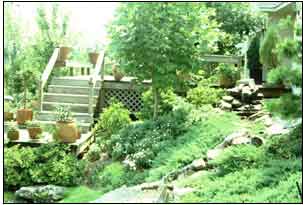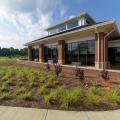Gardening on Steep Slopes
 Steeply sloping areas can provide many challenges and opportunities for property owners.
Steeply sloping areas can provide many challenges and opportunities for property owners.
Steep slopes are defined as areas of land that rise greater than twenty percent in angle. This translates to two feet of elevation change for every ten feet of walking area. Depending upon the soil type, slopes that are less than twenty percent are usually more stable and easier to maintain.
Steep slopes can create problems in the landscape. If these areas are in turfgrass, they are difficult and dangerous to mow with lawnmowers. A larger problem for steeply sloping areas is that they are often subject to soil erosion. Erosion problems from rainwater runoff can become so severe that large gullies can form. These gullies can continue to spread in size with each major rainfall as torrents of water wash through the gulch. If unchecked, severe erosion problems have been known to undermine the foundations of houses and other structures. Water naturally follows the lowest and easiest course, so it is best to retain or even create permanent drainage channels on steep slopes. Large permanent structures such as boulders and stones, or constructed check dams, can be placed into gullies to prevent further soil erosion.
Nature's solution: planting the slope
Nature solves erosion problems by using vegetation in even the steepest mountainous terrains. Trees and shrubs create a tight network of roots and stems that not only bind soil particles together, but also act to slow the force of rushing water down the hillside. Lawngrass on steep slopes can help to bind the soil with roots, but do not perform a very good job of slowing water runoff. Thus, heavy rains can wash away turf, roots and all. Taller growing grasses, wildflowers, and shrubs and trees do a much better job of slowing water runoff.
Sunny slopes
An open sunny meadow controls soil erosion better than a lawn area. To convert a lawn to a meadow, the existing lawngrass will need to be herbicided and then lightly tilled to provide a seed bed. Wildflower mixes are readily available in large quantities from seed companies and should be lightly sown into the area. It is useful to stabilize the loose soil until the wildflowers are established. This may be accomplished by spreading a light layer of fresh hay onto the slope as the hay particles bind and together and break the force of raindrops. Open plastic netting may also be used across the slope to prevent further erosion, and will decompose over time. Once established, the sunny flowering perennials will secure the slope and bind soil particles.
Other drought and sun tolerant plants that can secure steeply sloping areas include many shrub, vine and perennial species. Prostrate junipers, ivies, rugosa rose, and sedums can tolerate full sun conditions and a lack of watering and care. The use of an erosion fabric (plastic or cloth forms are available) coupled with the use of mulches that bind (such as pine needles or hay) will prevent weeds from occurring on the newly planted slopes.
Shady slopes
Even with the fibrous roots of shade trees, erosive areas can still form on woodland slopes. Shade tolerant shrubs may be used to plant these unstable areas, or by using shade groundcovers. Low growing vines, ferns, and perennials carpet the earth and bind the upper soil layers. Partridgeberry vine, wood fern, phlox, ivies, asian jasmine, and Boston ivy are just a few shade groundcovers that provide great beauty. Maintaining a thick carpet of fallen leaves can also break the force of raindrops and prevent erosion from becoming severe.
Human's solution: changing the slope
Our agricultural forefathers knew a thing or two about farming a steep hillside. To make it productive, and through much effort, they would terrace the slope. Terraces reduce erosion by breaking a long hillside slope into shorter, more even steps. It can provide for permanent architectural interest as well as creating more usable opportunities for gardens.
Many materials may be used for creating terraces. Treated wood, brick, rocks, concrete block and other masonry materials may be used to form walls. They can vary considerably in cost, durability, and cost of construction--depending upon the materials used and the size of the area to be terraced. Masonry and stone cost considerably more than wood materials, but more than make up for it in longevity.
Terraces are created by using a cut and fill method. Soil is removed to create a flat area, and this soil is used to fill a low area. It is recommended that homeowners doing their own construction limit their wall heights to just a foot or two high, as there is a tremendous amount of pressure of water and soil behind a retaining wall. It takes proper equipment, expertise, and proper drainage to successfully construct a large retaining wall, and a landscape architect should be consulted for proper materials and methods. Always check with local ordinances and building codes when considering retaining walls, terraces, or other constructed features.
Steep slopes can present challenges and creative opportunities in the home landscape. Whether nature's solutions or human solution's are utilized, thoughtful planning and execution can result in an attractive and workable landscape for a difficult area.
These factsheets were written by Robert F. Brzuszek, Assistant Extension Professor, The Department of Landscape Architecture, Mississippi State University.
Publications
News
Landscape design and natural landscape enthusiasts will gather at Mississippi State University to perfect their craft and learn from other experts, an annual event happening this year on Oct. 18. The 68th Edward C. Martin Landscape Symposium will be held from 8:30 a.m. to noon at the Bost Auditorium at MSU.
May is here and you know what that means, it’s go time!




